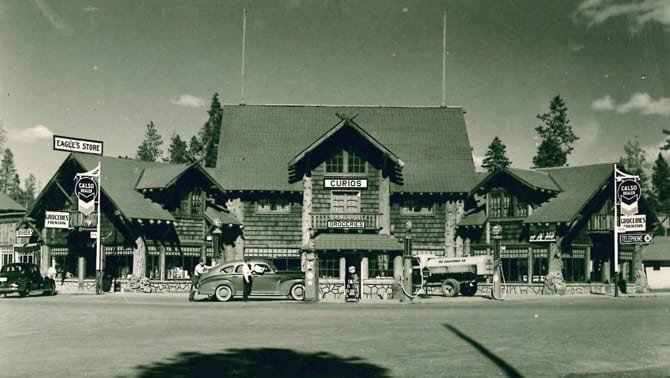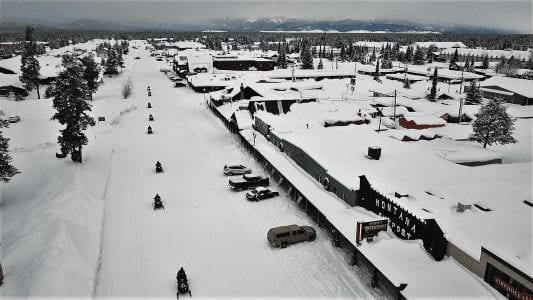The town of West Yellowstone, Montana, is – to say the least – unique. How did this town come about? In 1905 E. H. Harriman, president of the Union Pacific Railroad and Frank J. Haynes, president of Monida & Yellowstone Stage Line, made a trip to tour Yellowstone National Park. It was because of this visit the town of West Yellowstone came into being.
After their trip through Yellowstone, Mr. Harriman made the decision to construct a branch of the railroad from St. Anthony, Idaho to the west entrance of Yellowstone. He let no grass grow under his feet and by late November of 1907 the tracks had been laid. By June of 1908 the winter snows had cleared and the first “Yellowstone Special” steamed into what would become West Yellowstone. The “Yellowstone Special” made trips once a day from Salt Lake City to Yellowstone.
Our town was first named Riverside but in 1910 the name was changed to Yellowstone. As you can imagine, this created some confusion with the town having the same name as the National Park. In 1920 the name of the town was changed to West Yellowstone and remains that to this day.
Since the land was owned by the Forest Service, it was necessary for those wanting to reside or establish a business in the area to get permission from the Forest Service. Research shows that the first permits were granted to Charles Arnet, Sam Eagle and L. A. Murray. The original town consisted of 6 blocks. Once the land was removed from the Forest Service jurisdiction the town was enlarged to 22 blocks.
In 1907-1908 Charles Arnet built the Yellowstone Store and this was the first business in town. It was around this same time that Sam Eagle and Alex Stuart opened a general store. Later Alex Stuart bought the Yellowstone Store from Arnet and Sam Eagle and his wife continued to operate the general store. In 1920 they built a new “Eagle Store” which remains in operation today.

Eagles Store which is still in operation today in the same historic building. Photo courtesy of the Eagles Family.
In 1912 the Madison Hotel, consisting of 6 rooms upstairs and a lobby on the main floor was constructed. In 1921 14 rooms and a card room were added to the structure. A gift shop was added in 1959 and the business continues to be in operation during the summer months. When you are in town, be sure to stop by this establishment to get a little trip back into history.
The Union Pacific Dining Lodge was built in 1925. The dining room has 45 foot ceilings and a fireplace large enough for a man to stand in. It continues in operation to this day and can be rented for special occasions. It is a magnificent building and worth taking the time to walk in and look around. One can almost imagine having dinner here after a day of touring the park and boarding your train for the return trip.
In 1925 the Union Pacific Depot replaced the previous structure which was referred to as “the beanery” with the stone structure that today houses the West Yellowstone Historic Center. It is certainly worth you time to visit this historic building and get a sense of what the early train travelers experienced on their arrival to Yellowstone National Park. Train service to town was permanently discontinued in 1960.
Other buildings and businesses continued to appear as the town began to grow. A few of the first establishments would include Stuart’s Garage in 1917. Travel by auto, or ‘horseless carriage’ was becoming more and more popular with Yellowstone National Park as a destination. It was apparent that these travelers would need to purchase gas, oil and other automotive supplies and so Stuart’s Garage was established.
The need to provide opportunities to visit Yellowstone was apparent. Not all people traveled by car. Some were pilots desiring to visit the area. So, in 1935 on Forest Service land at the west edge of town the first airport was constructed. Some of the first planes to use this facility were privately owned snow planes. I would love to have seen one of them land during the winter. The construction of a new airport in 1963-1964 allowed for larger planes to service the area.
The train would cease operation for the winter generally in mid-September. Many of the residents would close up and leave town but for those that decided to “winter” in West Yellowstone they would stock up on food and firewood knowing that their only means of travel out of town was either by dog sled or by skis. However, in 1936 that all changed when the road to Bozeman was opened and kept plowed during the winter months. This made year-round travel in and out of town much easier. It is not known, but is assumed, that this enticed more and more residents to become year around “locals.”

Snowmobiling down Yellowstone Ave in West Yellowstone during the winter. Dobson Ent. Inc. photo.
Winters in our town continues to be harsh but this does not stop the snowmobilers taking advantage of the hundreds of miles of groomed snowmobile trails in the national forest surrounding the town. You cannot beat a snowmobile trip to Two Top on a sunny Montana winter day. The scenery is amazing and be sure to take your camera and plenty of film with you. Snowmobiles are allowed in the national park, but they must be the new less polluting variety and you must have a guide in order to go into the park. However, there are no restrictions on snowmobiling in the national forest.
Our town also boasts world class cross country skiing on the Rendezvous Trails at the edge of town. In November each year we host the West Yellowstone Ski Festival as well as other ski races throughout the winter season. Mid March brings the Annual Snowmobile Expo to town.
The Grizzly and Wolf Discovery Center is open year around with live grizzly bears and wolf packs available for your viewing pleasure. The I-Max theatre is also open during the winter showing feature films as well as documentary films on Yellowstone.
The “Kids ’N Snow” weekends, ice fishing on Hebgen Lake outside of town and the construction of a permanent ice skating rink at the city park have all been welcome additions that attract visitors to our town during the winter months.
Summer season brings the opening of the Playmill Theatre where college students produce and present broadway style plays. It sees business that have been closed for the winter open their doors with extended hours for the convenience of our summer visitors. It brings the opportunity to drive your personal vehicle into the park for a day of “geyser gazing” and animal sightings. The Earthquake Lake Visitors Center is open where you can learn about the devastating 1959 7.5 earthquake which unfortunately took several lives. The Smoking Waters Mountain Man Rendezvous takes up residence at the old airport on the west end of town for a couple of weeks in August featuring frontier time tents with lots of neat items to purchase as well as tomahawk throwing and flint lock contests.
There is so much to do here, both inside and outside the National Park.
Our town is literally “land locked” as it is surrounded on all sides by either Forest Service or National Park land. Those of us who choose to live here year-round appreciate our small town and both the summer and winter season.
AUTHOR: SUE KNAPP